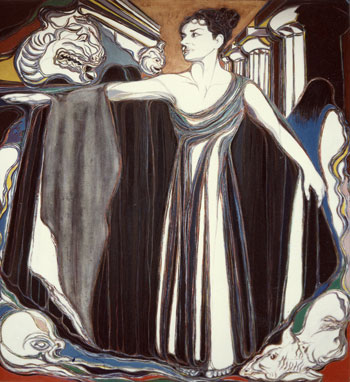Marisa Vescovo
Marisa Vescovo, 1984
 Homage to Maria Callas, 1998 - Mixed technique on canvas - cm 150x180 - Museum Pollenza, Macerata
Homage to Maria Callas, 1998 - Mixed technique on canvas - cm 150x180 - Museum Pollenza, Macerata
The painter Giuseppe Borrello wants above all to look in the present chaos, even if in many cases, it is always the past that speaks informing the present. At the base of the job of Borrello the equation sign is - form - color (to also intend as light).
NIn the sensuous, vitalistic sign, the echis can be tracked down of once in trial, that doesn't mark a measure or a sequence, but it can be read in vertical as poetry, in horizontal as water that passes and ripples, or wind that inflates and it makes to cheerfully fly the sails of an oscillating boat. For us that we look at this time of painting it is not anything else other than the tempestuous instant in which he lives the adventure of the “look”, that picks up the surprise and push toward the fantastic one.
The technique of Borrello consists of intervening on the graphic sign so that the run stirs according to a myriad of connotative runs, in a movement that disseminates sudden feelings of dizziness, but the audible sound leading is next to the “inexhaustible character of the murmur” that it is to the limit of a metaphysical silence.
The repetition of the graphic themes sections the body of the discourse, it divides it in particles, and therefore it determines the comparison of it, it establishes a bewilderment of the syntactic-graphic-chromatic and emotional levels. The pictorial language of the artist becomes a way to exist that it reproduces the secret world of its resistant desires of liberty.
The sign, together with the color, always timbre, ringing, Mediterranean, typically freed by the conditionings of a typical structure design, suffer some accidents, their progress breaks it in zones suspended to invisible threads of tension, as life is, in front of our wish of knowledge, when it is amended by the evil. In front of these pictures, in which sign and chromatic unravel their narrative plots, assist us without an order some De Chirico of the “Plazas of Italy”, the heavy subject of De Stael, the mistery apparitions of the expressionist cinema or the dreamlike cadences of the surrealism comes us to think that only the most rigorous simplification, and therefore the abstraction, can promise the revelation of the existence. Only thinning and pruning the life from the intrigue of strenuous details that envelop him as a thin, but veracious cobweb, of it the most authentic substance and detector can be freed, to conduct instantly us hot of happiness, that attacks us when we feel to be suspended in the space to historical of the sky,sea, or a vision coming from the daydream.
Borrello's last paintings, which are then those that intrigue us, the more iconic images tend to grow, to take up and pass as a blow-up, our field of vision, to engage other pictures which date back from the bottom of our archetypal matter, to mate to the artist.
The visual impression remains fixed in the retina, being already a fact of merely imaginary, but continues on its path to becoming a vision full of blunders, sometimes psychedelic, that give in times of electrocuting psychic, even before the surface of the canvas. The painter wants to trace, an horizon line, in which the eye meets hints of a divided, but musical, which disseminates the screen of inventories of memory.
And here we would say that the continuum color line closes, but opens the story that leads us towards a Borrello which has now landed a perfect thing, maybe grey-blue waters of Lake Garda.
Borrello is, today, not authoritarian tendencies in art, which have disappeared, but in that territory where the free experiences can be found. He is one of those “different” or “abnormal” than the approval, one of those “indeterminable” which cannot be fixed into a stereotype, and therefore cannot put his candidacy than a world in which differ in how bodies populated of multiplicity.
In everything we find the signs of a past, that it is rejoined to a naturalistic conception of the body and the desire, that can be a target, but also a point of anchorage. Or rather Borrello doesn't operate on a historical notion of myth, but he seeks a loaded reality of extraordinary events and of “lived”, that can have shown, but not completely explained: the image doesn't represent the thing, but it is the thing, filling so the distance between itself and the unity of the nature.




